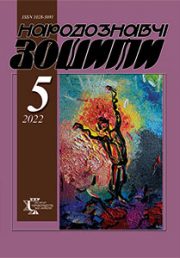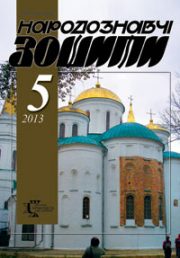The Ethnology Notebooks. 2024. № 5 (179), 1194—1202
UDK 070(477.8):[82-4:910.4]:94(477.87)”19″
DOI https://doi.org/10.15407/nz2024.05.1194
GABOR Vasyl
- ORCID ID: https://orcid.org/0000-0002-5482-4529
- CSc in Philology, Senior Research Fellow,
- Senior Researcher,
- Research Institute for Press Studies,
- Vasyl Stefanyk National Scientific Library of Ukraine in Lviv,
- 2, Stefanyk St., 79000, Lviv, Ukraine,
- Contacts: e-mail: vsgabor@gmail.com
KOMARYTSIA Mariana
- ORCID ID: https://orcid.org/ 0000-0003-2951-1237
- Doctor of Philology, Senior Research Fellow,
- Head of the Department, Research Institute for Press Studies,
- Vasyl Stefanyk National Scientific Library of Ukraine in Lviv,
- 2, Stefanyk St., 79000, Lviv, Ukraine,
- Contacts: e-mail: komar_mar@ukr.net
Abstract. The article analyzes travel essays about Carpathian Ukraine in the Western Ukrainian press of the interwar period, which are found to demonstrate syntheses of genres: i. e., transition of travel essays into analytical articles; their fusion with ethnographic research; a wide-ranging integration of historical events in the body of such essays, which makes the publications seem like historical research pieces; and structural combinations of essays with interviews. The materials by famous Ukrainian journalists, editors, writers, and political figures — Roman Holiian, Olena Kysilevska, Kharytia Kononenko, Zinaida Mirna, Mykola Chyrskyi, and others — comprehensively reveal the national identity of the autochthonous population of Transcarpathia, their historical and spiritual connection with the Ukrainian people in general, and their struggle against the effects of colonization. The authors were trying to establish the reasons for the variation in the names of the region, which in the 1920s and 30s had been a part of the Czechoslovak Republic with the rights of autonomy under the name of Carpathian Rus until its independence was declared under the name of Carpathian Ukraine. Thematically, the publications cover a wide range of subjects, which makes it possible to visualize the described journeys, to make sense of the forms of reflection of the national identity of Transcarpathian Ukrainians in the light of the ethnic characteristics of the inhabitants of Transcarpathia, descriptions of their customs and traditions, their linguistic situation, and polyethnicity, as well as to take into account the political context of the time. Travel essays about Carpathian Ukraine, which were published in periodicals such as Dilo, Nedilia, Nova Svoboda, Zhinocha Dolia, Samostiina Dumka, and Zhinka, made it possible for Western Ukrainian readers to get to know the history and culture of the region better as well as informed about the struggle of Transcarpathian Ukrainians for independence and instilled faith in the possibility of achieving independence for the whole of Ukraine.
Keywords: Western Ukrainian press, travel essay, synthesis of genres, national identity, Transcarpathia, Subcarpathian Rus, Carpathian Ukraine.
Received 29.08.2024
REFERENCES
- Belkova, S.V. (2014). Modifications of the Travel Essays in the Ukrainian Newspaper. Scientific Notes of the Institute of Journalism (Vol. 54, рр. 147—150). Kyiv [in Ukrainian].
- Holyk, R. (2020). Remembering Time and Space. Memoirs and Travel Literature in the Galician Cultural Tradition. Strategies of Memoir and Travel Literature by Western Ukrainian Writers of the second half of the 19th — the first half of the 20th century: Collective Monograph (Pp. 472—561). Lviv [in Ukrainian].
- Kovalova, T.V. (2014). Development of the Travel Essay Genre in Ukrainian Periodicals of the 1920s and 1930s: avtoref. dys…. kand. nauk iz sots. komunikatsii: 27.00.04. Dnipropetrovsk [in Ukrainian].
- Poliezhaiev, Yu.H. (2014). Travel Journalism as an Object of Scientific Reflection: Achievements, Problems, and Prospects. Psycholinguistics (Issue 16, pp. 322—331). Pereiaslav-Khmelnytskyi [in Ukrainian].
- Stetsiuk, K. (2015). Travel Essay Genre in the Pages of Galician Daily Press (Late 19th — Early 20th entury). Proceedings of Research and Scientific Institute for Periodicals (Issue 5, pp. 394—415) [in Ukrainian].
- Bovsunivska, T. (2009). Theory of Literary Genres. Kyiv: Publishing and printing center «Kyiv University»[in Ukrainian].
- Zdoroveha, V. (2004). Theory and Methodology of Journalistic Creativity (Pp. 142—157). Lviv [in Ukrainian].
- Mykhailyn, I.L. (2011). Basics of Journalism. A textbook (Pp. 368—385). Kyiv [in Ukrainian].
- Rozinkevych, N.V. (2019). Genre Specificity of Travel Literature Works. Transcarpathian Philological Studies (Issue 7, vol. 2, pp. 144—149). Uzhorod [in Ukrainian].
- Holovatskyi, Ya. (1938). Carpathian Ukraine 100 Years Ago. Nedilia, 49, 6—7 [in Ukrainian].
- Holovatskyi, Ya. (1938—1939). Carpathian Ukraine a Century Ago. Nedilia, 50, 6—7; 3, 6—7 [in Ukrainian].
- Chyrskyi, M. [M. Ch.]. (1935). Transcarpathia in the Traveler’s Eyes. Samostiina Dumka, 5/6, 365—377; 7/8, 494—506 [in Ukrainian].
- Holiyan, R. (1939). Back in Carpathian Ukraine. First Impressions from our Special Correspondent. Nedilia, 6, 3—4 [in Ukrainian].
- Kysilevska, O. (1938). Impressions from Subcarpathia. Zhinocha Dolia, 19, 3—4 [in Ukrainian].
- Holiyan, R. (1934). Where the Ukrainian Nation Awakens (Impressions from a Journey to Transcarpathian Ukraine). Dilo, 334, 2; 335, 2—3; 337, 2—3 [in Ukrainian].
- Holiyan, R. (1937). On the Other Side of the Carpathians. Impressions from a Staying in Subcarpathian Rus. Nedilia, 9, 3; 12, 8—9) [in Ukrainian].
- Kononenko, Kh. (1938). Beyond the Carpathians. Nova Khata, 21, 2—3 [in Ukrainian].
- Mirna, Z. (1935). Impressions from a trip to Subcarpathia. Zhinka, 20, 6—7 [in Ukrainian].
- Kysilevska, O. (1938). From a recent visit to Subcarpathia. Zhinocha Dolia, 21, 5—6 [in Ukrainian].
- Kysilevska, O. [O. K.]. (1938). At the cemetery in Rakhiv (in Subcarpathia]. Zhinocha Dolia, 24, 6—7 [in Ukrainian].
- (E.) (1930). On the other side of the Carpathians. Journey through Transcarpathian Ukraine (From our correspondent). Nedilia, 8, 4—5; 9, 9; 10, 9 [in Ukrainian].
- Borshosh-Kumiatskyi, Yu. (1939). Tourism Needs to Be organized! Nova Svoboda, 10, 3 [in Ukrainian].






